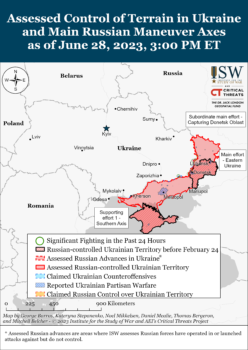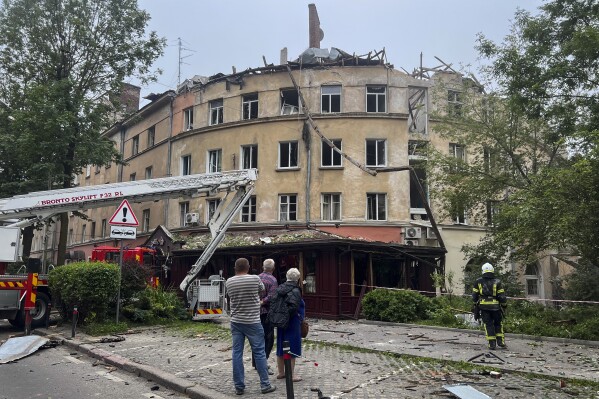Aftermath of a Russian Kalibr cruise missile strike on an apartment block in Lviv, Ukriane, July 6, 2023 (Mstyslav Chernov/AP)
Wednesday’s Coverage: Zelenskiy — Russia May Sabotage Zaporizhzhia Nuclear Power Plant

Map: Institute for Study of War
UPDATE 1732 GMT:
Ukraine’s foreign exchange reserves are at their highest level since independence in 1991, because of financial support from international partners.
Central Bank Governor Andriy Pyshnyi said of the almost $39 billion, “This level of reserves strengthens the National Bank of Ukraine’s ability to continue maintaining exchange rate stability.”
Ukraine’s foreign exchange reserves were $37.3 billion at the start of June.
UPDATE 1451 GMT:
Former senior US officials had secret talks with Russian Foreign Minister Sergey Lavrov during Lavrov’s trip to New York in April, according to “half a dozen people briefed on the discussions“.
Lavrov spoke with the group for several hours. The Americans included Richard Haass, a former Director of Policy Planning at the State Department and the outgoing president of the Council on Foreign Relations; Charles Kupchan, a specialist on Europe; and Russia expert Thomas Graham.
The sources said the goal was to keep channels of communication open with Russia and to establish where there might be room for future negotiation. The talks took place with the knowledge of the Biden Administration, but not at its direction. The former officials briefing the National Security Council after the discussions.
The sources said discussions have also involved Russian academics, leaders from major think tanks or research institutes, and others who have access to the Kremlin. Two people briefed on the talks said Mary Beth Long, a former US Assistant Defense Secretary with expertise on NATO, was also present.
At least one former US official has traveled to Russia for discussions.
A Ukraine Government official commented, “Our position is unchanged — the fate of Ukraine cannot be decided without Ukraine. Many times the President and all our official speakers spoke about it. Not anonymously, but quite specifically and publicly.”
In April, Around the same time Haass and Kupchan wrote a lengthy article in Foreign Affairs, which is published by the Council on Foreign Relations, laying out what they described as “a plan for getting from the battlefield to the negotiating table.”
In the piece, Haass and Kupchan wrote in Foreign Affairs that the US should pursue a new approach because of a likely stalemate after Ukraine’s counteroffensive.
The US should prepare for a ceasefire propose in which both Russia and Ukraine would pull forces back from the front line, “effectively creating a demilitarized zone, they said.
“A neutral organization — either the UN or the Organization for Security and Cooperation in Europe — would send in observers to monitor and enforce the cease-fire and pullback,” they wrote. “Assuming a cease-fire holds, peace talks should follow.”
UPDATE 1448 GMT:
The death toll has risen to five from this morning’s Russian cruise missile strike on an apartment block in Lviv.
UPDATE 1400 GMT:
Ukraine now has more tanks than Russia, according to Dutch, British, and German monitors of military equipment.
Ukraine has an estimated 1,500 tanks compared to Russia’s 1,400.
Before Vladimir Putin’s invasion in February 2022, Russia had 3,400 tanks and Ukraine 987.
Moscow’s stock has been depleted by battlefield losses while Kyiv has been boosted by international aid.
The Russian military has lost about 2,000 tanks, 400 howitzers, and 260 MLRS rocket launchers, according to the monitors.
Russia now has 1,900 152/155mm howitzers, while Ukraine has 1,100. Moscow still has a 841 to 427 advantage in MLRSs.
UPDATE 1334 GMT:
A “senior Biden Administration official” says the US will soon announce that it will provide Ukraine with cluster munitions.
Earlier today, Human Rights Watch called on both Russia and Ukraine to refrain from use of the munitions, citing civilian casualties in areas such as Izyum in northwest Ukraine (see 0628 GMT).
More than 130 countries have signed a 2008 treaty banning the munitions, but the US, Russia and Ukraine are not among them.
UPDATE 1126 GMT:
The Russian rouble is continuing to sink to its lowest level since March 2022, just after the start of Vladimir Putin’s invasion of Ukraine.
The rouble stood at 102.007 v. the euro and 93.85 v. the US dollar on Thursday morning.
Central Bank Chairman Elvira Nabiullina blamed “the dynamics of foreign trade”. She maintained that the bank “has tools to smooth out short-term fluctuations”.
UPDATE 1121 GMT:
Russian shelling has set afire and destroyed the railway station building in Odnorobivka in the Kharkiv region in northeast Ukraine.
UPDATE 1117 GMT:
Ukraine President Volodymyr Zelenskiy is in Bulgaria for discussions with Prime Minister Nikolai Denkov and Foreign Minister Mariya Gabriel.
Zelenskiy said the talks covered “defense support, Ukraine’s Euro-Atlantic integration, the NATO summit, security guarantees, and the implementation of the peace formula”.
He confirmed at a joint press conference that the two countries agreed on more active cooperation in the defense sector, and that he has invited Bulgaria to take part in Ukraine’s reconstruction.
We discussed the military aid which Bulgaria gives to our country. We count on the continuation of the cooperation which has already saved many lives.
Bulgaria is reportedly close to agreeing the sale of two Russian-made nuclear reactors and other critical equipment to Ukraine’s State nuclear energy company Energoatom.
UPDATE 0854 GMT:
Lviv Governor Maksym Kozytskyi has updated on this morning’s Russian missile strike killing at least four civilians and injuring 34 in an apartment block in Lviv city.
Rescuers continue to clear the debris. There may still be people under them. Work will continue until the last hope.
Among the fatalities were a 60-year-old mother and her 32-year-old daughter.
Kozytskyi said the launch of 10 Kalibr cruise missiles, seven of which were intercepted, was “the most destructive attack on the civilian population in the Lviv region since the beginning of the full-scale war”.
More than 30 houses, 250 apartments, and 10 hostels are damaged. An electricity sub-station has been knocked out, leaving 150 people without power.
UPDATE 0841 GMT:
The head of Ukraine military intelligence, Kyrill Budanov, says the threat of Russian sabotage at the occupied Zaporizhzhia Nuclear Power Plant is decreasing.
Budanov, who raised the alarm last month, suggested that statements about the threat — including from Ukraine President Volodymyr Zelenskiy this week — as well as private contacts had deterred the Russians.
“We take certain actions in this sphere, both public and non-public, and I think that now the danger of an artificial man-made disaster is gradually decreasing,” he said.
However, he warned, “It’s not eliminated. As long as the station is occupied this can happen again any time if they want.”
UPDATE 0755 GMT:
Belarus leader Aleksandr Lukashenko says Yevgeney Prigozhin, the leader of the Wagner Group mercenaries, is no longer in the country but has returned to Russia.
Under the June 24 deal ending Wagner’s 36-hour rebellion against the Kremlin, Prigozhin was supposed to move to Belarus. However, Lukashenko said the mercenary head is back in St Petersburg.
This is a Russian company. So the question is clearly not for me. As far as I am informed, the fighters are in their camps. As for Prigozhin, he is in St Petersburg. It does not exist on the territory of Belarus.
Later, Lukashenko suggested, “Where is [Prigozhin] this morning? Maybe he went to Moscow in the morning.”
He said, that he “absolutely does not see any risks” from the deployment of Wagner fighters inside Belarus.
Also he suggested Progozhin might be in Moscow instead of St Petersburg, saying “As for Yevgeny Prigozhin, he is in St Petersburg.
In its latest propaganda volley against Prigozhin, the Kremlin released photos of the June 24 raid on his opulent residence in St. Petersburg. The pictures includes Prigozhin’s selfies in an assortment of wigs.
The Russian security forces continue to allow leaks to the media after the searches of Yevgeny Prigozhin.
This time a part of his selfies archive was published.
Which Prigozhin are you today? pic.twitter.com/YNyV9elL9p
— NEXTA (@nexta_tv) July 5, 2023
UPDATE 0743 GMT:
Ukraine’s counter-offensive has made further gains on the eastern front in the Donetsk region.
Geolocated footage confirms advances around the city of Bakhmut, including to the northwest near Berkhivka, to the north near Yahidne (2 km to the north), and to the southwest.
The Ukrainian General Staff reported offensive operations south and north of Bakhmut. Deputy Defense Minister Hanna Maliar spoke of advances to the south, without specifying an area.
Ukrainian MP Yuriy Mysyagin claimed forces have established a position north of Opytne, 6 km northwest of the outskirts of Russian-occupied Donetsk city.
On the southern front, Gen. Oleksii Hromov said the counter-offensive has liberated nine settlements and 160 square km (61.8 square miles) near the Zaporizhzhia-Donetsk border.
UPDATE 0628 GMT:
Human Rights Watch has called on both Russia and Ukraine to stop using cluster munitions that have killed Ukrainian civilians.
The organization’s report was published on Thursday as the US considers supply of the munitions to Kyiv. HRW urged Washington to turn down Ukraine’s request.
The activists cited their visit to recently-liberated Izyum in northeast Ukraine last autumn, where they investigated Russian abuses of Ukrainian civilians.
During the visit, they interviewed witnesses who spoke of fragments from submunitions that detonated around their homes during the Russian occupation. HRW concluded that at least eight civilians were killed and 15 wounded by the clsuter weapons, and that the actual toll was likely to be much higher.
More than 120 countries are part of an international treaty banning the munitions, but Russia, Ukraine, and the US are not among them.
UPDATE 0609 GMT:
Ukraine President Volodymyr Zelenskiy says the slow delivery of weapons to Kyiv delayed the current 3 1/2-week counteroffensive, allowing Russia to build up defenses in occupied areas of the east and the south.
The CNN interview was broadcast on Wednesday but recorded in the port city of Odesa days earlier.
Our slowed-down counteroffensive is happening due to certain difficulties in the battlefield. Everything is heavily mined there.
I wanted our counteroffensive happening much earlier, because everyone understood that if the counteroffensive will be unfolding later, then much bigger part of our territory will be mined.
Zelenskiy reiterated, “I’m grateful to the US as the leaders of our support, but I told them as well as European leaders that we would like to start our counteroffensive earlier, and we will need all the weapons and material for that.”
In his nightly address to the nation, Zelenskiy spoke aboutthe forthcoming NATO summit in Lithuania’s capital Vilnius, the possible Russian sabotage of the Zaporizhzhia Nuclear Power Plant, and the situation on the battlefield.
#Zelenskyy: There is exactly one week left until the key day of the #NATO summit in #Vilnius. That means a week until the key moment for our common security in Europe. pic.twitter.com/yR0wnf8jkl
— NEXTA (@nexta_tv) July 5, 2023
ORIGINAL ENTRY: At least four civilians have been killed and 34 injured in Russia’s missile strike on an apartment block in Lviv in western Ukraine.
Seven sea-launched Kalibr cruise missiles were downed, but three others evaded air defenses and one destroyed the top two floors of the four-story apartment block. The governor of the Lviv region, Maksym Kozytski, said about 60 apartments and 50 cars were damaged.
Emergency services rescued seven people from the rubble, but fear more victims will be found. Kozytski said, “We are doing everything possible to…save people.”
The strike was the first on Lviv, Ukraine’s sixth-largest city, since a June 20 drone attack.
Ukraine President Volodymyr Zelensky posted on Telegram, alongside video of the damaged building, “Consequences of the night attack by Russian terrorists. There will definitely be a response to the enemy. A tangible one.”
President #Zelenskyy published a video showing the aftermath of the #Russian attack on the civilian infrastructure of #Lviv.
At least four people were killed. pic.twitter.com/k9XvjHn1ON
— NEXTA (@nexta_tv) July 6, 2023


Trackbacks/Pingbacks